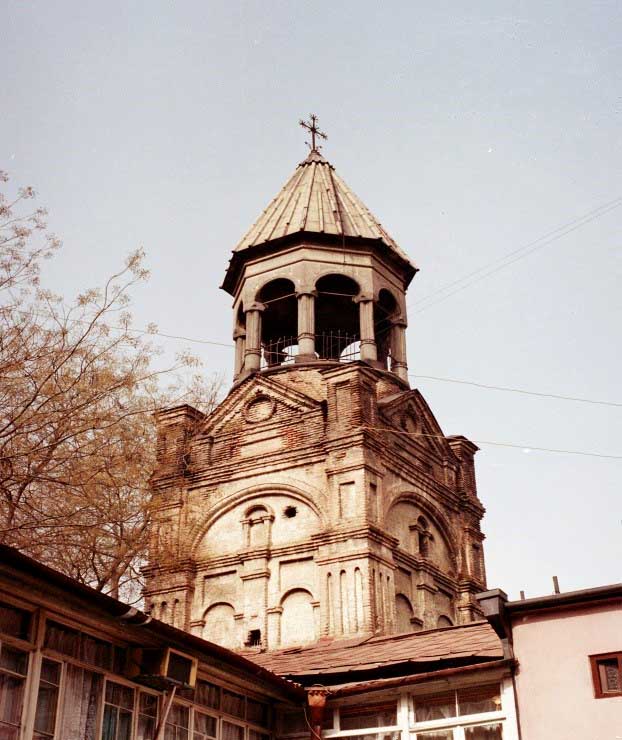VANK (MONASTERY) CATHEDRAL CHURCH
THE CHURCH WAS ESTABLISHED IN 931. In 1938 ARMENIAN MONASTERY (VANK) OF TIFLIS WAS DESTROYED. ONLY THE BELFRY IS STILL STANDING FROM THE WHOLE ARMENIAN MONASTERY COMPLEX. AT THE PLACE OF THE VANK NOW IS THE PUBLIC SCHOOL N104 OF TBILISI.
Establishment and reconstructions: On the right bank of the Kura River, on the former Garetubani street of Tbilisi (now Atoneli) was located the Vank (Monastery) Cathedral church or the Harants Monastery, where, the headquarters of the Armenian Diocese in Georgia until the Soviet years was.
Regarding the foundation date of the Vank Cathedral, the sources and professional literature report contradictory views, but the most likely date is 931[1].
The church has undergone several renovations and reconstructions. One of the first repairs was carried out in 1430,[2] but the major reconstruction was done in 1480. It was so magnificent that later that year was noticed by Armenian and Georgian researchers as the date of its foundation. In the 19th century, the Vank Cathedral was equipped with new structures: a museum, gate, and church headquarters, the record of its construction is fixed in the wall of the belfry and still exists[3].
Architecture: The brick-built temple had a three-nave domed basilica composition with three pairs of pillars. All naves were finished in the east with semi-circular, equal-sized altars. The middle one of the three altars was dedicated to St. Astvatsatsin (Holy Mother of God), the southern one to St. Gregory the Illuminator, and the northern one to St. Apostles. However, the entire temple was named St. Astvatsatsin. The large domes had high, twelve-sided drums with a pyramidal top. All dome drums had tall and narrow windows. Entrances were opened from the north, east, and south sides. A four-pillared portico was attached to the south entrance. The main facade of the temple was formed by arrow-shaped arches with rectangular flat niches[4].
Belfry: The Vank Cathedral was once the largest church building in the city. The church complex included the two-story building of the priest, residential rooms, and a gate. In the southwest corner of the monastic complex, the three-story belfry was built on the gate, the high volume of which ended with a pillared rotunda. Now only the belfry is preserved. It rises on a high plinth. There is a four-pillar octagonal nave above ending in a conical canopy. The first floor standing on the plinth presents itself as a gate with open semi-circular arches. The structure and ornaments of the facades are made in classical style. The sides of the building are decorated with masonry columns. The walls are decorated with arches and niches of various sizes. The gate is supported by a hemispherical arch. Staircases with brick treads for climbing to the upper floors of the belfry run through the thickness of the walls.
The second and third floors of the belfry have the same design structure. The rectangular storehouse is covered by a hemispherical arch. All four walls of the floors are connected by semicircular arches[5].
Church History Museum: In 1897, with the benevolence of Avetis Ghukasyan, the construction of the religious history museum of Vank Cathedral began[6]. Church valuable items were to be kept in the museum. On February 21, 1902, on the occasion of the Feast of St. Vardan the Warrior and His Companions and by Catholicos Khrimyan Hayrik, the opening ceremony of the museum was solemnly held. By the decision of the Tbilisi city authorities, the museum building was completely demolished in 1939[7].
Cemetery: Vank Cathedral was also known for its national cemetery. It has existed since at least the Middle Ages, but not enough measures have been taken to preserve and care for this historical and sacred monument. That is the reason why the tombstones found in the cemetery and preserved until 1939 belong to the 19th and 20th centuries. The remains of prominent Armenian figures and diocesan primates were buried in the cemetery of the Vank Cathedral[8].
Properties: Detailed information about church-owned properties is reported in the bulletins of the diocesan church properties. According to such a bulletin from 1837, the church owned both a number of valuable church items and immovable properties in the form of land, stalls, and houses[9]. The property called "Big and Small Islands" on the banks of the Kura River also belonged to the church.
Members of brotherhood and churchwardens: Among the members of the brotherhood of Vank Cathedral were priests Rev. Fathers Ghevond Kharazyants, Yeznik Yerznkyants, Gyut Aghanyan, Grigor Khojaeniatyans, Calouste Abulyants[10]. Among the churchwardens and trustees were Zakar Mamulyan, S. Shahverdyan, M. Melikyan[11], Gevorg Ter-Ghukasyan, Grigor Okroyants, Hovsep Hovsepyants[12].
Vank Cathedral church in the Soviet period: In the 1920s and 30s, Vank Cathedral church, despite being in a state of neglect, continued to function. In 1937, the Armenian cemetery of the Harants Monastery was destroyed by the Soviet authorities, and in 1938, the destruction of the Armenian Monastery in Tbilisi was organized. Only the belfry, which now is a private property, is standing from the complex of the once-famous Vank Cathedral. Public school N104 of Tbilisi is currently located on the site of the monastery.
[1] P. Muradyan, Armenian Churches of Old Tiflis, St. Etchmiadzin, 2009, p. 161:
[2]NAA, ֆ. 332, in the same place:
[3] Norashen, 2007/1 (7), p. 7-8:
[4]M. Hasratyan, The architecture of the Armenian churches of Tbilisi, “Etchmiadzin”, 2009/6, p. 70:
[5]Center for the Study of Armenian Historical and Cultural Heritage in Georgia. Armenian Diocese in Georgia.
[6]NAA, ֆ. 53, ց. 1, գ. 228, թ. 1, 7 և շրջ.:
[7]Norashen, 2007 /1/ 7/ p. 7-8:
[8]Norashen, in the same place:
[9]See the detailed list: NAA, ֆ. 56, ց. 6, գ. 39, թ. 8-9 շրջ.:
[10]NAA, ֆ. 35, ց. 1, գ. 551, թ. 1-ի շրջ.:
[11]NAA, ֆ. 35, ց. 1, գ. 551, թ. 51:
[12]NAA, ֆ. 35, ց. 1, գ. 332, թ. 2:
 Հայերեն
Հայերեն  ქართული
ქართული  English
English  Русский
Русский 


